Alaska
-
- Infrastructure for Alaska’s LNG and Other Resources Maritime Reporter, Jun 2013 #22
Trans Arctic Shipping Routes (TASR)
It is time for the global maritime industry to push development of Trans Arctic Shipping Routes (TASR) and port facilities along Alaska’s northern coast. Not only for shipping goods from the Pacific to Atlantic and vice versa, but specifically to facilitate development of specialized ports for LNG exports from Alaska to global markets.
Alaska has a limited maritime community mostly in the south: Southeast Alaska is a maritime community; South Central, Valdez, The Kenai Peninsula and Anchorage much less so; Southwest Alaska and Aleutians have fishing fleets and the Western, North Slope coasts and, the Interior have only marginal connections to large scale maritime activities. Nearly all Alaska’s vast energy resources, LNG and coal, are on the North Slope.
Today in Alaska there is a heated debate over LNG pipeline routing, as all scenarios call for LNG pipelines from the North Slope to Valdez (for export) or Anchorage for electricity production, domestic heating and in-state industrial use. To my knowledge, no studies of impacts of increased ship traffic into the small Port of Valdez or the limited Port of Anchorage have been done.
Both proposals call for an 800-mile pipeline: One, a large diameter high-pressure pipeline to Valdez, the other, a smaller, low-pressure line to Anchorage with a possible spur to Fairbanks. And, separately, there is a proposed gas conditioning plant on the North Slope for a trucking operation to bring heating fuel to Fairbanks.
Under either scenario, not all regions of Alaska share in utilization of North Slope LNG which is in conflict with Alaska’s economic construct as an ”Owner State,” wherein all parts of Alaska are accorded equal benefit from Alaska’s natural resources.
Developing maritime infrastructure on the North Slope will facilitate development of the TASR and transit across the Arctic Basin between the Pacific and Atlantic and it should be part of the debate. Thinning arctic ice, purpose built ships and specialized port facilities for exporting LNG from North Slope tidewater to world markets would establish an anchor for commerce across the TASR. For the Alaska’s LNG producers and the state, a North Slope LNG export facility makes economic sense for all. Exporting LNG directly from the North Slope eliminates 800 miles of pipeline and about $50 billion in development costs. It also creates a revenue stream for the producers and the state faster.
For Alaska’s residents, North Slope LNG Export means a more rapid distribution of resource revenue to them, and developing Alaska’s North Slope LNG export infrastructure does not impair additional development of in-state energy, domestic heating or industrial use through appropriately sized LNG pipeline projects.
As background, in 1992 I joined an Alaskan delegation to Finland for the International North Sea Routes Conference hosted by the Finnish Foreign Trade Association, The Finnish-American Chamber of Commerce and the State of Alaska. My interest was development and financing a transshipment cargo port at Dutch Harbor in the Aleutians.
In preparation, I gathered National Oceanic and Atmospheric Administration (NOAA) charts and polar maps and read volumes of reports. Delegation members also made an inventory of Alaskan products for export and products being shipped between the Pacific and Atlantic via the Panama Canal. Also studied were statistics on products shipped from Europe to Asia via Suez Canal or around the Capes.
In doing so, we came to believe the TASR offered an opportunity for the global shipping dynamic: vastly shorter distances offer shorter port-to-port transit times that will potentially amount to hundreds of billions of dollars in reduced operating costs and saving to clients, not to mention reduced energy use, emissions as well as less exposure to disasters inherent on current routes.
Weather and ice conditions do present formidable challenges. We also learned other Arctic nations had more focus on the Arctic than the U.S., and that Alaska had no authority to create or operate the TASR. Finland was building icebreakers and assisting Russia with the Shtokmanovskoye Gas Prospect in the Barents Sea. And as we grew familiar with the Shtokmanovskoye Project, we realized Alaska’s resources had commercial volumes of natural gas that could support creating necessary LNG conditioning, pipeline and loading facilities on the North Slope. Not to mention the potential of exporting the Point Lay High-BTU, Low-Sulfer, low ash exportable “clean” coal. We toured icebreakers, reviewed remote sensing technologies capable of providing real time analysis of ice conditions and we visited facilities that simulate ice conditions on ships. With all this enhanced knowledge, we became convinced of the technical ability to construct purpose built ships (see attached student drawn SWATH concept drawing below) and loading facilities suited for the TASR.
We envisioned a “mirror” development to the Shtokmanovskoye project in Alaska. Instead of bringing natural gas onshore for conditioning and shipment south, Alaska’s natural gas (and high BTU, low sulfer coal) could be sent offshore three to five miles through a pipelines inside sub-surface tunnels to loading platform where purpose built Very-Large Ice-Classed LNG Ships could transport the gas to markets in Asia or Europe. We were confident of the Finnish shipbuilders experience and ability to build the ships.
With this knowledge we returned to Alaska and presented the possibilities. Unfortunately, interest in exporting LNG via the TASR waned as then Governor Hickel left office and a new Environmental Industry backed anti-development administration took control.
Fast forward 20 years and technology has advanced non-stop, from computers and communication to LNG transportation and distribution. In maritime LNG transportation, Submerged Turret Loading (STL) Buoys and Icebreaking Offshore Facilities exist. Tunnel Boring Machines (TBM’s) can tunnel the sub-sea floor, eliminating many environmental impacts, and, the development can be done at a considerably lower cost than a $70 billion dollar large-diameter line proposed from the North Slope to Valdez or Anchorage.
In October 2012, The TransCanada Corporation proposed a rerouted project to Anchorage and detailed it to Alaska’s Governor Parnell. The update reportedly claims it will cost about $70 billion for a North Slope gas treatment, conditioning plants, and 800-mile pipeline to Southcentral Alaska including a LNG storage facility and tanker terminal to export 15 to 18 million metric tons of LNG annually.
The 800-mile pipeline is only one element of total cost, as an over the life of the pipeline to a southern tidewater, numerous costs will be imposed: A per mile fee for maintenance, remediation, etc., will be paid to the pipeline’s owners as rent for the line and all that will far exceed the cost anything anticipated for a three to five mile sub-seafloor pipeline to Arctic tidewater.
In every scenario, ships must be built.
A Q-max sized LNG ship at 1132 x 177 ft. carries about 266,000 cu. m. tons of LNG and costs $200-300 million to build To export LNG from the North Slope, 10 to 15 purpose-built ships must be constructed for between $2b and 4.5b. Even with that cost added to the North Slope export facilities, the estimated development should be $50b less than crossing Alaska to Anchorage, and the timeline is compressed.
Most importantly for Alaskans, the differential capital cost between proposed pipelines going south, plus facilities and ships and, TASR North Slope LNG export will be significant. On the surface it is $50b, ample capital to fund both in-state domestic gas heating distribution systems as well as, a full spectrum of in-state industrial developments when practical and profitable.
So, does the TASR development benefit Alaskans more than 800-mile pipeline south? In a word, yes. Alaska’s leaders say Alaska’s resources belong to “us,” the people. However in reality, Alaska’s resources belong to the State and the State is mandated to manage them for the highest benefit of the Alaskan people. If that is correct, then producing resource revenues for less cost on a shorter schedule brings the highest benefit.
(As published in the June 2013 edition of Maritime Reporter & Engineering News - www.marinelink.com) -
- Taming the Arctic, One Ferry at a Time Marine News, Jan 2015 #36
Ferries for Alaska’s harsh conditions, built in Alaska by Alaskans. Vigor and Elliott Bay Design Group team up for a winning combination as the new Alaska Class Ferry Project takes shape. With its network of islands and fjords, rugged mountains and spectacular tidewater glaciers, Alaska’s Inside Passage
-
- Derecktor Wins AMHS Fast Ferry Deal Maritime Reporter, Mar 2002 #41
Derecktor Shipyards has emerged victorious in the battle to build a pair of high speed ferries for the Alaska Marine Highway Systems. Late last month, Paul Derecktor, Alaska Governor Tony Knowles, State Department of Transportation Commissioner Joe Perkins and several Alaska State Officials attended
-
- Alaska Pipeline Background Information -Tankers Required To Cost $1.6 Billion Maritime Reporter, Mar 1974 #14
Alyeska Pipeline Service Company— The agent company formed to design, ibuild, operate and maintain the Trans-Alaska Pipeline for the seven owners: Amerada Hess Corporation; ARCO Pipe Line Company; Exxon Pipe Line Company; Mobil Pipe Line Company; Phillips 'Petroleum Company; Sohio Pipe Line Company
-
- Experience Counts in the Arctic Marine News, Nov 2014 #66
efficiencies and a steady, experienced hand in the region. For everyone involved, that’s the ideal combination. At the Helm Lori Davey, a lifelong Alaskan and resident of Anchorage, joined Fairweather in 2012 as director of business development. Prior to that, she owned and served as president of Motznik
-
- Alaska’s (Hidden) Frontier Marine Technology, Sep 2016 #18
Terrestrial Alaska has been widely explored and economically understood for over a century. While we have a handle on this, we know little about what lies underneath the surface of sounds, seas, gulfs and oceans. Regulated by U.S. law, the Exclusive Economic Zone extends 200 miles from shore, providing
-
- Op-Ed: Alaska's Golden Offshore Opportunity Marine News, Oct 2016 #18
Offshore energy presents a golden opportunity for Alaska and the United States. As we enter the final quarter of the year, one of the last and most pressing pieces of business facing the Interior Department is to finalize its next offshore leasing program, which will specify exactly which parts of the
-
- YANMAR Cruises Into Alaska with Power to Spare Marine News, Mar 2018 #38
occurring thousands of miles to the northwest at about the same time, YANMAR was beginning the installation of its first 6AYAM-ET mechanical engine in the Alaskan fishing markets. A retrofit contract, the advent of YANMAR in Alaska was as much a milestone as was the opening of the EVO//Center. That’s because
-
- MarAd Awards Contracts To Study Port Needs In Alaska, Hawaii, Oregon Maritime Reporter, Dec 1978 #40
has awarded contracts totaling in excess of half a million dollars for the assessment of present facilities and future needs of ports in Alaska, Hawaii, and Oregon, Robert J. Blackwell, Assistant Secretary of Commerce for Maritime Affairs, announced. In its continuing program to promote
-
- Willamette Awarded $15 Million To Modernize Alaska State Ferry Maritime Reporter, Sep 1977 #9
The State of Alaska has awarded Willamette Iron & Steel Company, Portland, Ore., a $15,228,- 500 contract to lengthen and modernize the M/V Matanuska, an Alaska state ferry. Work will begin in October, with c o m p l e t i o n scheduled for May 1978. WISCO will employ approximately 350 shipyard
-
- Shipowners Seek To Enjoin Alaska State Tanker Law Maritime Reporter, Oct 15, 1977 #28
, Mobil Oil Corporation, and Union Oil Company of California in the Federal District Court of Anchorage to block enforcement of the Alaska State Tanker Law and related implementing regulations which became effective Friday, September 16. In announcing this action, Mr. Reynolds noted
-
- Alaska Maritime Names William Lorch Valdez Port Manager Maritime Reporter, Nov 15, 1977 #36
William C. Lorch has joined Alaska Maritime Agencies, Inc., as Valdez port manager, according to an announcement by David R. Enroth, general manager of the Seattle, Wash.-based steamship agency. Mr. Lorch served previously with Cascade Shipping Company in various managerial capacities. In his new
-
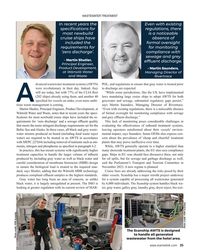 )
January 2024 - Maritime Reporter and Engineering News page: 35
)
January 2024 - Maritime Reporter and Engineering News page: 35challenges in that meets the more stringent discharge requirements set for the evaluating the effectiveness of onboard treatment systems, Baltic Sea and Alaska. In these cases, all black and grey waste- leaving operators uninformed about their vessels' environ- water streams produced on board (including food
-
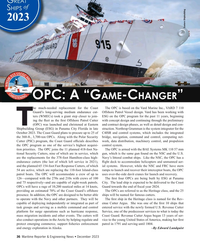 )
December 2023 - Maritime Reporter and Engineering News page: 36
)
December 2023 - Maritime Reporter and Engineering News page: 36of America, making her ? rst protect emerging commerce, support ? sheries enforcement patrol in 1791 and serving until 1804. and energy exploration in Alaska. –By Edward Lundquist 36 Maritime Reporter & Engineering News • December 2023 MR #12 (34-44).indd 36 12/5/2023 5:55:44 P
-
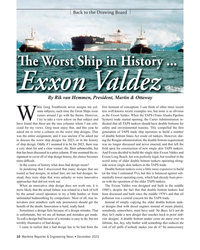 )
December 2023 - Maritime Reporter and Engineering News page: 10
)
December 2023 - Maritime Reporter and Engineering News page: 10issue less well-known recent examples too, but none is as obvious comes around I go with the theme. However, as the Exxon Valdez. When the TAPS (Trans Alaska Pipeline WI try to take a view askew on that subject and System) trade started opening, the Carter Administration in- have found that these are the
-
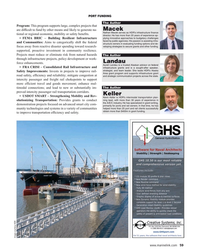 )
November 2023 - Maritime Reporter and Engineering News page: 59
)
November 2023 - Maritime Reporter and Engineering News page: 59risk from natural hazards The Author through infrastructure projects, policy development or work- Landau force enhancements. Aurah Landau is a trusted Alaskan advisor on federal • FRA CRISI – Consolidated Rail Infrastructure and infrastructure grants and is a sought-after speaker, strategist, and team
-
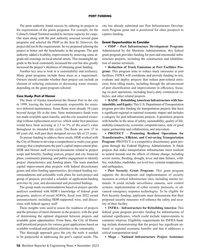 )
November 2023 - Maritime Reporter and Engineering News page: 58
)
November 2023 - Maritime Reporter and Engineering News page: 58ef? ciency, focus- ing on port operations, including heavy-duty commercial ve- Case Study: Port of Homer hicles, and other related projects. The State of Alaska transferred the Homer Port to the city • RAISE – Rebuilding American Infrastructure with Sus- in 1999, leaving the local community responsible for
-
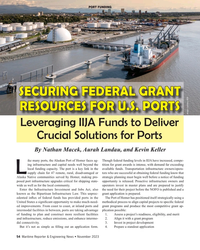 )
November 2023 - Maritime Reporter and Engineering News page: 54
)
November 2023 - Maritime Reporter and Engineering News page: 54. PORTS Image courtesy HDR Leveraging IIJA Funds to Deliver Crucial Solutions for Ports By Nathan Macek, Aurah Landau, and Kevin Keller ike many ports, the Alaskan Port of Homer faces ag- Though federal funding levels in IIJA have increased, compe- ing infrastructure and capital needs well beyond the tition
-
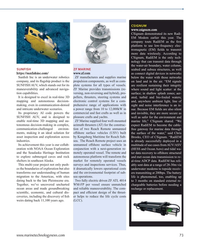 )
September 2023 - Marine Technology Reporter page: 73
)
September 2023 - Marine Technology Reporter page: 73of use cases from AUV/ASV oration with NOAA Ocean Exploration conjunction with a next-generation re- (HESS and Ocean Aero) and tidal wa- and the Seaalaska Heritage Institution motely operated vessel. The remote and ter data recovery to offshore structural to explore submerged caves and rock autonomous
-
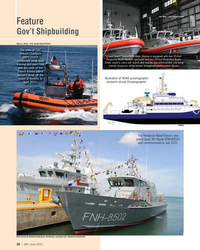 )
June 2023 - Marine News page: 30
)
June 2023 - Marine News page: 30Gray / U.S. Coast Guard Feature Gov’t Shipbuilding Ryan L. Noel / U.S. Coast Guard Photo The crew of CGC William Chadwick Coast Guard Station Ketchikan, Alaska is equipped with two 45-foot (WPC-1150) Response Boats-Medium (pictured and two 29-foot Response Boats- conducted small boat Small, used to carry
-
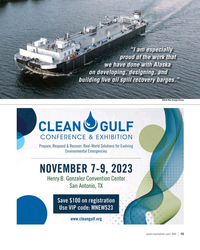 )
August 2023 - Marine News page: 15
)
August 2023 - Marine News page: 15“I am especially proud of the work that we have done with Alaska on developing, designing, and building ? ve oil spill recovery barges.” Elliott Bay Design Group www.marinelink.com MN 15|
-
 )
August 2023 - Marine News page: 14
)
August 2023 - Marine News page: 14projects of every kind. But I am especially proud of the work that we have done they have a job to do and a mission, and they can’t just say, with Alaska on developing, designing, and building ? ve oil “Oh, that sounds cool, let’s give it a go and try it.” We have spill recovery barges. Gunderson built
-
 )
April 2023 - Maritime Reporter and Engineering News page: 24
)
April 2023 - Maritime Reporter and Engineering News page: 24. BSEE inspectors that go out on the road to the Gulf of Mex- [Looking at how oil and gas differs from offshore wind], ico, to the west coast, and to Alaska to conduct risk-based I think they are different risk pro? les, and in the future, I inspections. will ? ag carbon sequestration, as we’re currently
-
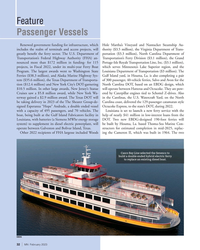 )
February 2023 - Marine News page: 32
)
February 2023 - Marine News page: 32, and the Program. The largest awards went to Washington State Louisiana Department of Transportation ($3 million). The Ferries ($38.3 million), and Alaska Marine Highway Sys- Gulf Island yard, in Houma, La. is also completing a pair tem ($35.6 million), the Texas Department of Transporta- of 300 passenger
-
 )
November 2022 - Maritime Reporter and Engineering News page: 56
)
November 2022 - Maritime Reporter and Engineering News page: 56something familiar to the people who work the The largest vessels included are a car of a wharf rat and occasionally talked waters from Puget Sound to Alaska are ferry and a NOA research ship. A coast my way onto ? shing boats and tugs to represented in the book. Two big beefy guard cutter is paired
-
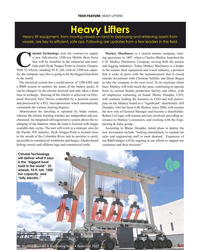 )
November 2022 - Maritime Reporter and Engineering News page: 50
)
November 2022 - Maritime Reporter and Engineering News page: 50of the Columbia River and its position is easily sales and engineering staff to meet demand. Expansion of accessible to commercial workboats and barges, Alaska-based our R&D budget will be ongoing in our efforts to support our ? shing vessels and offshore tugs and commercial crafts. customers and their missions
-
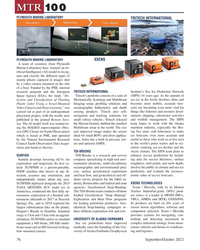 )
September 2022 - Marine Technology Reporter page: 76
)
September 2022 - Marine Technology Reporter page: 76released and wildlife management. The SIPN ing. The AI model itself was trained us- the Micron Gemini, dubbed the smallest team hopes to work with the Alaska ing the MAGEO supercomputer (Mas- Multibeam sonar in the world. The size maritime industry, especially the Ber- sive GPU Cluster for Earth Observation)
-
 )
September 2022 - Marine Technology Reporter page: 2
)
September 2022 - Marine Technology Reporter page: 2..................................................62 Iridium ...............................................................................33 University of Alaska Fairbanks Geophysical Institute .......76 iXblue ..........................................................................59, 67 UTEC (an Acteon
-
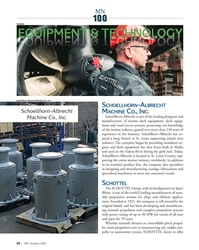 )
October 2022 - Marine News page: 68
)
October 2022 - Marine News page: 68long history in St. Louis supporting inland river industry. The company began by providing steamboat en- gines and deck equipment for river boats built in Alaska and used on the Yukon River during the gold rush. Today, Schoellhorn-Albrecht is located in St. Louis County, sup- porting the entire marine industry
-
 )
October 2022 - Marine News page: 48
)
October 2022 - Marine News page: 48total ownership cost.” from across the U.S., from New York to California and Bowles said the ? rm recently supported OceanAero with South Carolina to Alaska. its Triton platform, a sail- and solar-powered, autonomous As the worldwide imperative for cleaner, greener vessels unmanned surface vessel (USV)
-
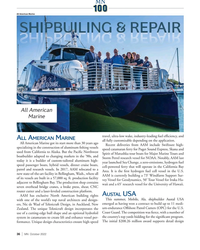 )
October 2022 - Marine News page: 36
)
October 2022 - Marine News page: 36high- specializing in the construction of aluminum ? shing vessels speed catamaran ferry for Puget Sound Express, Skana and used from California to Alaska. But the Paci? c Northwest Spirit of Matushka tour boats for Major Marine Tours and boatbuilder adapted to changing markets in the ’90s, and Storm
-
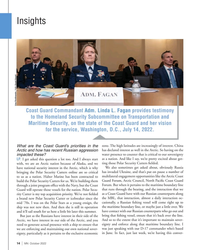 )
October 2022 - Marine News page: 14
)
October 2022 - Marine News page: 14asked this question a lot too. And I always start as a nation. And like I say, we’re pretty excited about get- with, we are an Arctic nation because of Alaska, and we ting those Polar Security Cutters ? elded. We also sometimes get asked about, obviously Russia have national security interest in the Arctic
-
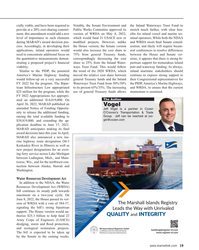 )
September 2022 - Maritime Reporter and Engineering News page: 19
)
September 2022 - Maritime Reporter and Engineering News page: 19for an exist- ing ferry service across Lake Michigan between Ludington, Mich., and Mani- towoc, Wis., and for the northwest con- nection between Alaska, Hawaii and Washington. Water Resources Development Act In addition to the NDAA, the Water Resources Development Act (WRDA) bill continues its steady
-
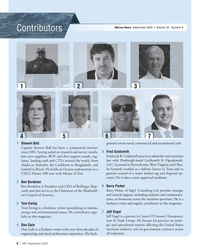 )
September 2022 - Marine News page: 6
)
September 2022 - Marine News page: 6B. Goldsmith practices admiralty and maritime boats, landing craft and CTVs around the world, from law with Pittsburgh-based Goldsmith & Ogrodowski, Alaska to Australia, the Caribbean to Bangladesh, and LLC. Licensed in Pennsylvania, West Virginia and Ohio, Iceland to Brazil. He holds an Oceans endorsement
-
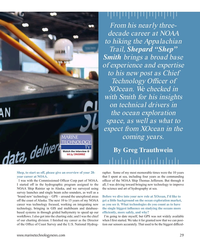 )
July 2022 - Marine Technology Reporter page: 29
)
July 2022 - Marine Technology Reporter page: 29it I started off in the hydrographic program assigned to the all, I was driving toward bringing new technology to improve NOAA Ship Rainier up in Alaska, and we surveyed using the science and art of hydrography at sea. survey launches and single beam echo sounders, as well as a ‘brand new’ technology
-
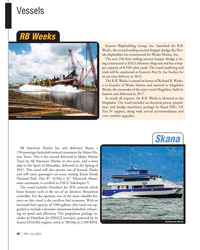 )
July 2022 - Marine News page: 39
)
July 2022 - Marine News page: 39American Marine in two years, and a sister ship to the Spirit of Matushka, delivered in the Spring of 2021. This vessel will also operate out of Seward, Alaska and will carry passengers on tours visiting Kenai Fjords National Park. This 87’ (LOA) x 32” Teknicraft Alumi- num catamaran, is certi? ed to USCG
